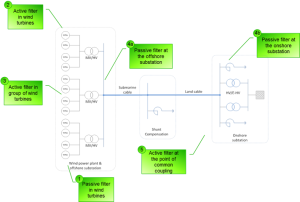There are various techniques for dealing with the harmonic problem in large wind power plants (WPPs) depending upon the nature and source of the problem.
Large offshore WPPs are characterized by complex structures including wide application of power electronic devices in wind turbines, FACTS devices and/or HVDC transmission. Moreover, there is a large amount of passive components such as filters, cable arrays, transformers, transmission cables, and shunt compensation equipment. Consequently, there are many potential sources of harmonic problems, and simultaneously many ways of dealing with them [1].
Primarily there are two methods of harmonic mitigation in a WPP: (i) avoiding harmonic resonance by design and (ii) design and use of filters [2]. A good design involves system layout, component selection and controller tuning with the aim of avoiding potential resonance conditions in the WPP.

Both passive and active filtering could be used for harmonic mitigation. It is recognized that passive filtering is the state-of-the-art technology. However, it requires extensive knowledge of the system during the WPP design phase. In many cases information about the system is uncertain and over-sizing of passive filters may take place to cover uncertainties and risks.
Due to the fact that more and more power electronic equipment (e.g. wind turbines with grid connected converter, STATCOMs, HVDC, etc.) is being utilised in WPPs, active filtering appears to be an interesting solution.
Active filtering can be implemented at the converter control level, thereby avoiding or reducing the need for installing expensive passive filters. Moreover, active filter controllers could be tuned and re-tuned, sometimes adaptively, to overcome the uncertainties faced during the WPP design phase [3].
A comparison between passive and active filters including major factors is presented in Table 1. It can be easily seen that there is a potential in active filtering and the technology is improving.
| Indices | Passive filters | Active filters |
| Technology | Known | Improving |
| Reliability | High | Medium |
| Effectiveness | Medium | Good |
| Engineering time | Large | Medium |
| Power electronics | No | Yes |
| Energy storage | Large | Small |
| EMI | No | Yes |
| Control circuit | No | Yes |
| Voltage regulation | No | Yes |
| Dynamic response | Slow | Fast |
| Cost | Low | High |
Considering the different attributes, probably hybrid solutions involving both the passive and the active filters at various locations, as shown in Fig. 1, would be the most beneficial for effective harmonic mitigation scheme. In order to optimize the WPP design from harmonic emission and stability perspective some more studies and research is required [4]. The hybrid solutions would comprise of:
- Passive filtering at the wind turbine level:
- trap filters designed for carrier group harmonics filtering,
- high-pass filters for high frequency content,
- detuned C-type filters with limited bandwidth, etc.
- Active filtering at the wind turbine level:
- selective harmonic compensation,
- high-pass active filtering,
- harmonic rejection capability,
- active notch filters, etc.
- Active filtering in groups of wind turbines:
- carrier signals de-synchronization,
- phase shifter transformer groups, etc.
- Passive filtering at the WPP level – 4b) onshore or 4a) offshore:
- detuned C-type filters,
- double-tuned filter, etc.
- Active filtering at the WPP level:
- shunt connected FACTS devices,
- HVDC link, etc.
[1] V. Akhmatov, J. Nygaard Nielsen, J. Thisted, E. Grøndahl, P. Egedal, M. Nørtoft Frydensbjerg, and K. Høj Jensen, "Siemens Wind Power 3.6 MW Wind Turbines for Large Offshore Wind Farms," in Proc. 7th International Workshop on Large Scale Integration of Wind Power and on Transmission Networks for Offshore Wind Farms, 26-27 May 2008, pp. 494-497.
[2] M. Bradt, B. Badrzadeh, E. Camm, D. Mueller, J. Schoene, T. Siebert, T. Smith, M. Starke, and R. Walling, “Harmonics and resonance issues in wind power plants,” 2011 IEEE PES General Meeting, Jul. 2011.
[3] Ł. H. Kocewiak, "Harmonics in Large Offshore Wind Farms," PhD Thesis, Aalborg University, Aalborg, 2012.
[4] P. Brogan, "The stability of multiple, high power, active front end voltage sourced converters when connected to wind farm collector systems," in EPE Wind Energy Chapter Seminar, Stafford, 2010, pp. 1-6.

2 replies on “Harmonic mitigation methods in wind power plants”
Great work!
i am very glad to read your excellent work. Hope you will keep continue this act. Thank you